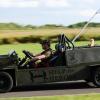
Smiths Temp Gauge Wiring?
#1

Posted 31 January 2010 - 09:27 PM
i have the 3 speedo clocks that are to the left hand side NOT in the centre.
my temprature gauge on the speedo has stoped working and i want to wire in a smiths gauge?
question is how do i wire it in?
i have been told that one of the spade connectors on the gauge is a earth and the other one is for a wire that comes off the clocks. i think theres a 10amp resisor or something that there are wires come off and go the the fuel guage and the temprature guage. and all i have to do is to take the wire of the standard temprature gauge and extend it to the smiths clock i have.
is this correct??
or is there a easyer way to wire this on???
#2

Posted 31 January 2010 - 09:47 PM
#3

Posted 31 January 2010 - 09:56 PM
one goes to earth, one to the lighting circuit, and the last one to the temp sender in the head
#4

Posted 31 January 2010 - 10:01 PM
#5

Posted 01 February 2010 - 01:46 AM
The basic temp gauge connections are:
green/blue wire from the sending unit to EITHER of the gauge's spade lugs. (it doesn't matter which one)
light green wire from the second gauge spade lug to a 10V supply (not 12V) (more on that below)
red (or red/white) wire from the gauge lamp to the lamp wiring in the dash.
gauge case = earth (for the lamp). Usually a ring terminal is crimped to a black wire and the ring terminal goes over the threaded stud used to mount the gauge. The other end of the black earth wire is connected to any good earthing spot behind the dash.
The gauges are powered by 10V, not 12V. They are powered by the voltage stabilizer. This is a small rectangular metal canister typically with a mounting ear on it. On center binnacle cars it is attached to the top, back side of the speedometer. On later cars, I believe it is mounted on the back of the gauge cluster. Others will have to tell you how to tap into that 10V source if you want to use what's already there.
There are modern replacements available for the voltage stabilizer and you could also buy one of those, wire it into the dash, and use it to provide the 10V to your gauge.
#6

Posted 01 February 2010 - 06:43 AM
Sy
#7

Posted 01 February 2010 - 09:30 AM
so one wire striaght from the sender in the head to the gauge,
another wire from the voltage stableiser.
and them the light is easy to wire in and eath the casing off?
does that sound correct.
ive got the 3 clocks that are to the right not the centre.
any one know where the voltage stabeliser is or what it looks like???
#8

Posted 01 February 2010 - 10:05 AM
#9

Posted 01 February 2010 - 10:23 AM
does it work by having that 10v input to the guage and then the other wire to the sender does that earth it out but adds a resistance that the gauge picks up and its convereted to show a temprature???
#10

Posted 01 February 2010 - 11:24 AM
#11

Posted 01 February 2010 - 01:03 PM
1) Do NOT run the gauge on 12V, and
2) The gauge works by internal resistance heating.
The two answers are tied together so here is a little more detailed explanation.
Inside the gauge is a bimetallic element (a flat strip of two metals bonded together). This strip will bend when its temperature changes because of the different coefficients of expansion the two metals have. This strip is wrapped with a resistance heating wire. One end of the metal strip is anchored, the other is connected loosely to the gauge needle. One end of the resistance wire goes to the 10V source, the other is connected to the sending unit.
The sending unit (temperature or fuel) is a variable resistor. 10V is supplied to one gauge terminal and the electric current flows through the resistance wire, out the gauge, down the wire to the sender and finally to earth. As the sending unit's resistance value changes it "throttles" the current and therefore the heating of the resistance wire inside the gauge. The more current that flows, the more heat generated, the more expansion there is of the bimetallic strip and therefore... more displacement of the gauge needle (hot and/or full).
The problem is that current and voltage are proportional. If you increase the voltage supplied to the system but the resistance values remain the same, the current has to increase. So if you supply 12V you are supplying 20% more voltage (and current) than the gauge was designed for. Thus, it will read high and physically the gauge itself will run hotter than intended which will shorten the life of the gauge and sending unit.
HOWEVER, you cannot talk about supplying a gauge 12V... that only happens when the engine is not running. As soon as you start the engine and the alternator starts producing electricity and the car's voltage system is no longer at 12V, it is at 14V or more. So, you will not be running your temperature gauge with 12V (or 20% too much voltage), you will be running around 14V, or 40% too much voltage and current. Yes the gauge will work but it will not be accurate and it won't last long.
#12

Posted 01 February 2010 - 01:09 PM
so simple really!!!
easy few wires and im done.
what does the 10v regulator look like???
#13

Posted 01 February 2010 - 02:40 PM
http://classicstabil...information.htm
#14

Posted 01 February 2010 - 03:10 PM
and can i just take the wire of the stabeliser that goes to my exstising temprature gauge and connect it to my smiths clock??
#15

Posted 01 February 2010 - 04:07 PM
You said your car is a 1993. I don't know when Minis started using the Nippon Seiki gauges. That will determine where your stabilizer is.
If you have Nippon Seiki gauges, the stabilizer is built into the temp or fuel gauge... buried in the gauge cluster itself. If you have Smiths gauges, the stabilizer will be stuck on the back of the gauge cluster as implied by the exploded diagram in the PDF linked below:
http://www.theminifo...x...st&id=86491
The Nippon Seiki gauges were discussed recently in a couple of threads. Most recently a FAQ developed by board member Stormintrooper.
http://www.theminifo...howtopic=146533
Hopefully those two links will help you identify which gauges you have.
1 user(s) are reading this topic
0 members, 1 guests, 0 anonymous users
















